A place for me to infodump about Ancient Greece and Greek mythology(I am in no way a historian, I am just a student with a massive interest in Ancient Greece and a desperate need to yap.) my main is @Ohgodthehorrors69
Don't wanna be here? Send us removal request.
Text
Current wip of Hector of Troy!!

I might make multiple versions of his armour, who knows…
ALSO


His clothes are removable!! Hes like an ancient greek dress up doll
64 notes
·
View notes
Text
My trojan war brainrot has gotten so bad im dreaming about it😔
3 notes
·
View notes
Text
Inshallah every woman achilles has wronged gets to beat him to death
85 notes
·
View notes
Text

wip of polyxena my beloved 🙏🙏
10 notes
·
View notes
Text
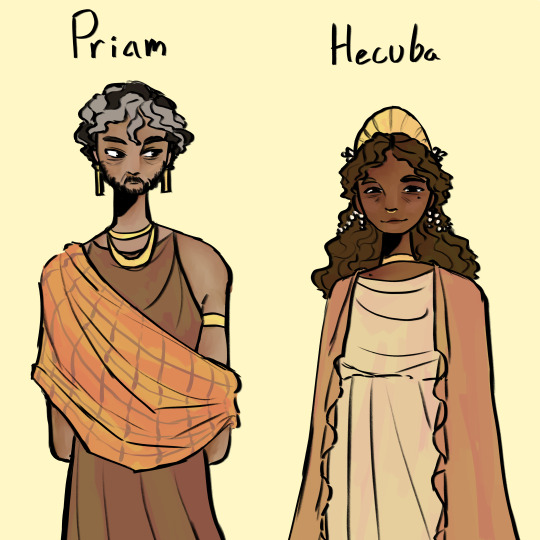
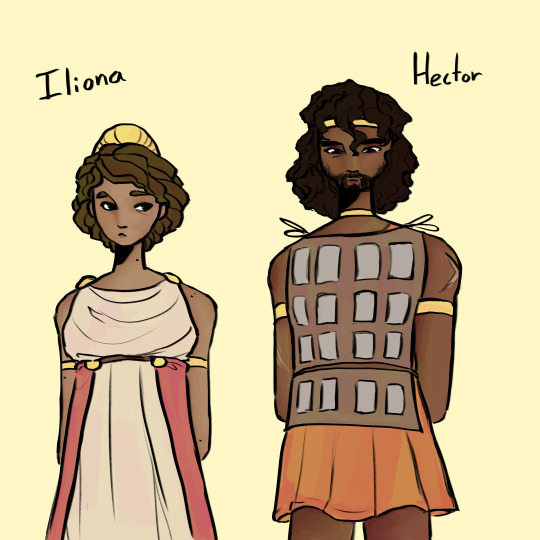
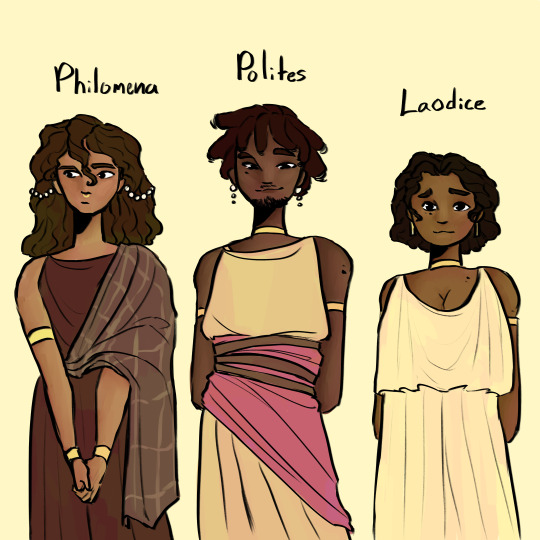
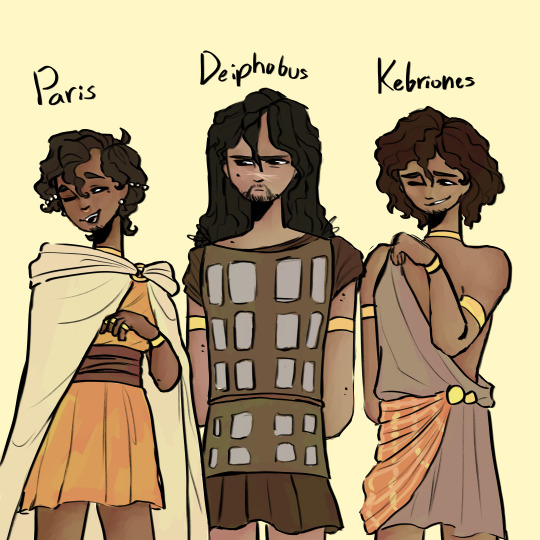
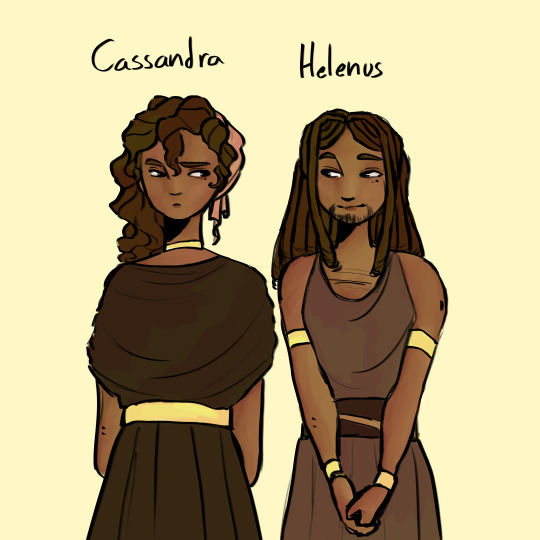
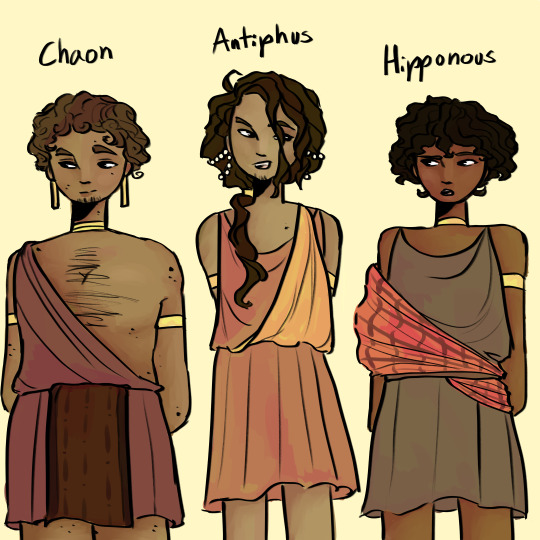
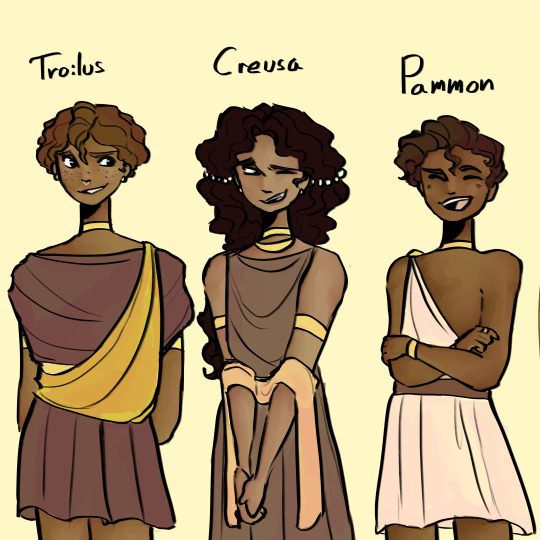
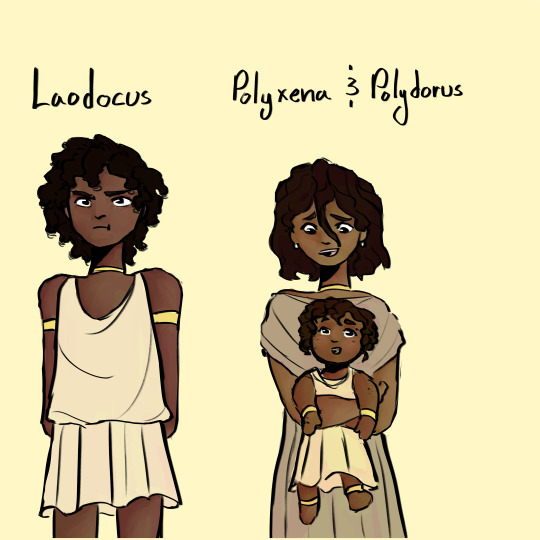
"Sunny!" you cry, "Why did you draw the entire Trojan royal family from oldest to youngest in two days? That seems wildly unhealthy!"
"hurghhhhhhhh" I reply.
Anyways here's the full family portrait

(Only four of these people survive the Trojan war btw :D)
919 notes
·
View notes
Text
Got the (foolish lol) idea to go through some of the works I know give physical descriptions of at least some Trojan war characters and collate them. They aren't in alphabetic order, sorry, but the works/authors are colour coded, at least!
I'll do this in two parts; this one for Achaean characters, the next one for Trojans. Watch Philostratus fanboy over Palamedes and Protesilaos (why????) and marvel, when compared to basically everyone else's description, across all works!
Helen The Iliad: 'terribly does she seem like the immortal goddesses to look on' (spoken of her, not narration), divine/shining/noble among women In Hesiod and other works she is given the xanthos = blond/auburn/etc epithet Dares: Helen resembled Castor and Pollux. She was beautiful, ingenuous, and charming. Her legs were the best; her mouth the cutest. There was a beauty-mark between her eyebrows. (Castor and Pollux: they were twins, blond haired, large eyed, fair complexioned, and wellbuilt with trim bodies.) Malalas, Chronographia: full-grown, well-dressed, with fine breasts, white as snow, with beautiful eyebrows, a beautiful nose, shapely, curly-haired, blonde-ish, with big eyes, charming, with a beautiful voice, a formidable sight among women. She was 26 years old. Tzetzes, Antehomerica: white, with soft skin and beautiful eyebrows and nose. Her skin was so white and bright as if it was made of snow. She had lovely breasts and a pretty face; she had languishing and large eyes and a melodious charming voice; she had long, curly, blond hair; she was well-behaved and perfect in everything she did; she was a lot more beautiful than all the other women, just like the moon is brighter than all the stars in the sky. At that time she was twenty six years old.
Agamemnon The Iliad: '[…] tell me the name of this gigantic man. […] To be sure there are other men even greater in height, […] handsome, nor so majestic, for he seems a kingly man.' Dares: blond, large, and powerful. He was eloquent, wise, and noble, a man richly endowed. Philostratus, Heroicus: Agamemnon and Menelaos were alike neither in appearance nor strength. […] He looked majestic and magnificent and like the sort of person who offered sacrifice to the Graces. Tzetzes, Posthomerica: white, big, of a wide chin and dark hair. He was well-bearded, well-educated, resembling the blessed ones.
Menelaos The Iliad: xanthos = blond/auburn/bright, 'standing towered with his broad shoulders. Dares: moderate stature, auburn-haired, and handsome. He had a pleasing personality. Philostratus, Heroicus: Agamemnon and Menelaos were alike neither in appearance nor strength. […] [he] wore his hair boyishly long, as was the Spartan custom, and the Achaeans made allowance for him when he was visiting, since they did not mock those who came from Euboea even though their hair was ridiculously long. He says he conversed most easily and very concisely, mixing pleasant speech with his discourse. Tzetzes, Posthomerica: the bodily frame smaller [than Agamemnon]; he had a breadth, though. He had a red skin, dense beard and blond hair.
Odysseus The Iliad: 'lesser in height than Agamemnon […], but he seems broader in the shoulders and chest.' (Also shorter than Menelaos.) Dares: tough, crafty, cheerful, of medium height, eloquent, and wise. Philostratus, Heroicus: extremely skilled in public speaking and clever, but he was a dissembler, a lover of envy, and praised malice. His eyes were always downcast, and he was the sort of person who engages in self-examination. He appeared more noble than he was in military matters; surely he was not well versed in preparing for war, in commanding naval battles and sieges, or in drawing of spear and bows. Tzetzes, Posthomerica: middle-aged, pot-bellied, white, with plain hair, nose looking down and fiercely glaring.
Achilles Dares: a large chest, a fine mouth, and powerfully formed arms and legs. His head was covered with long wavy chestnut-colored hair. Though mild in manner, he was very fierce in battle. His face showed the joy of a man richly endowed. Philostratus, Heroicus: For Achilles' physique appeared startling and divine […] When he became an ephebe, a brightness radiated from his face, and his body was beyond natural size, since he grew more easily than do trees near springs. […] hair is thick, lovelier than gold, and becoming no matter where and how either the wind or he himself may move it. His nose is not quite aquiline, but almost so; his brow is crescent-shaped. The spirit in his eyes, which are bluish-gray, casts off a certain eagerness even when he is still; when he is rushing on, they spring out along with his purpose, and then he seems more lovely than ever to those who cherish him. (long hair until Patroklos dies) Tzetzes, Posthomerica: tall, of a beautiful chest, graceful in everything, white, of blond curly and thick hair. He had a big nose, melodious voice and the eyes of a woman. His glance was terrible, in a race was swift-footed; he had long legs and scanty beard.
Patroklos Dares: handsome and powerfully built. His yes were gray. He was modest, dependable, wise, a man richly endowed. Philostratus, Heroicus: Patroklos, although he was not much older than Achilles, was a divine and sensible man, […] In size and bravery he was between the two Ajaxes. He fell short of the son of Telamon in all things, but he surpassed both the size and bravery of the son of Locris. Patroklos had an olive complexion, black eyes, and sufficiently fine eyebrows, and he commended moderately long hair. His head stood upon his neck as the wrestling schools cultivate. His nose was straight, and he flared his nostrils as eager horses do. Tzetzes, Posthomerica: middle-aged, potbellied and well-bearded. He had blond hair, red skin and lovely face.
Ajax, the son of Telamon The Iliad: 'outstanding among the Argives in height and broad shoulders' ; repeatedly called only second to Achilles in everything but looks. Dares: powerful. His voice was clear, his hair black and curly. He was perfectly single-minded and unrelenting in the onslaught of battle. Tzetzes, Posthomerica: brave, great, quick, with a nice nose and curly hair; He had a dark skin; he was well-bearded and grim-looking. He was more beautiful than everybody, except for Achilles.
Ajax, the son of Oileus The Iliad: lesser [than Ajax the great] by far, for he was a small man […] Dares: stocky, powerfully built, swarthy, a pleasant person, and brave. Philostratus, Heroicus: appeared less intelligent [than Diomedes and Sthenelus] […] looking fierce, and throwing his long hair back Malalas, Chronographia: tall, strong, tawny, squinting, good nose, curly hair, black hair, thick beard, long face, daring warrior, magnanimous, a womanizer. Tzetzes, Posthomerica: tall and had bright eyes. He was nice, had long face and dark curly hair.
Diomedes Dares: stocky, brave, dignified, and austere. No one was fiercer in battle. He was loud at the war-cry, hot-tempered, impatient, and daring. Philostratus, Heroicus: steadfast and having eyes that are blue-gray and not black at all and a straight nose; his hair was woolly and dirty. […] modest upon rebuke, checked the eruption of his anger, and refused to insult the troops or to be disheartened. He himself considered it appropriate for an army to appear unwashed, and he commended sleeping in any opportune place; his provisions consisted of what was available, and he did not take pleasure in wine unless troubles came upon him. Diomedes and Sthenelos were the same age. Tzetzes, Posthomerica: [he had a] body that was worth of four young men. He was in good shape with a flat nose, narrow neck and blond hair.
Sthenelos Philostratus, Heroicus: a good size and towering, gray-eyed, with an aquiline nose, fairly long-haired, ruddy, and hot-blooded. […] lacked Diomedes' insight, his power of speech, and his patient endurance which belong to both soul and body. He gave way to anger, was contemptuous of the throng of battle, was savage upon being rebuked, and was prepared for a more delicate lifestyle than was needed for a military camp.
Nestor Dares: large, broad and fair. His nose was long and hooked. He was a wise adviser. Philostratus, Heroicus: (statue, but also the real man?) with a beard that is majestic and well-proportioned; his ears display what he went through at wrestling school, and his neck is restored to its strength. In truth, Nestor stands upright, not defeated by old age, with black eyes and without a drooping nose. Tzetzes, Posthomerica: big, had a nose looking downwards and a fiercely glaring. He had a long face, flame-coloured skin, blond hair and he was wise.
Antilochos The Iliad: Younger than the rest. Philostratus, Heroicus: Because Antilokhos was still young and not mature enough for war when they assembled at Aulis, his father did not agree to his wish to serve as a soldier. (he arrives in the fifth year.) For Achilles' physique appeared startling and divine, but that of Antilokhos seemed to all to be pleasant and gentle. […] Antilokhos resembled Nestor, but that he was swifter, trim in physique, and paid no attention to his hair. He gave me the following details about Antilokhos: He was most fond of horses and hunting with dogs. Tzetzes, Posthomerica: younger than the other Achaeans. Almost a boy, he was white, with a beautiful neck and a big nose. He was storm-footed, provoked fear with his eyes and a beard just sprouting. He was blond with beautiful hair and grey eyes.
Neoptolemus Dares: large, robust, and easily irritated. He lisped slightly, and was good-looking, with hooked nose, round eyes, and shaggy eyebrows. Philostratus, Heroicus: he was good-looking and resembled his father, but was inferior to him in the same way that beautiful people are inferior to their statues. Malalas, Chronographia: of good stature, good chest, thin, white, good nose, ruddy hair, wooly hair, light-eyed, big-eyed, blond eyebrows, blond beginnings of a beard, round-faced, precipitate, daring, agile, a fierce fighter. Tzetzes, Posthomerica: red hair, that's why many had called him Pyrrhus. He was of young age, white or somewhat grey, the colour of the milk; He had beautiful nose and chest, hair curly and was daring; He hadn't ever been hurt, embittered, reckless and of a too wild temper; Thin tiny hair was growing from his beard.
Palamedes Dares: tall and slender, wise, magnanimous, and charming. Philostratus, Herocius: So then in height he was the same as the greater Ajax; in beauty, Protesilaos says, he vied with Achilles, Antilokhos, Protesilaos himself, and with the Trojan Euphorbus. His soft beard was springing up and with the promise of curls; his hair was cut close to his skin; his eyebrows were noble, straight, and came together above the nose, which was perfect as a square and stately. The resolve of his eyes appeared unshaken and fierce in battles, but when he was at rest their gaze was full of comradely affection and affable; he also is said to have possessed the most marvelous eyes among mortals. And in truth, Protesilaos also says that when he was naked, Palamedes weighed halfway between an athlete and a lithe person, and that he had a toughness about his face that was much more pleasant than the golden locks of Euphorbus. Tzetzes, Antehomerica: He was tall, white, with his hair blond and filthy; he was slim and had a long face; he was a servant of wisdom and of Ares. His hair was blond and visibly dirty, because he didn't trouble himself with stupidities like his hair.
Podalirius Dares: sturdy, strong, haughty, and moody.
Nireus The Iliad: the most beautiful man to come beneath Ilion of all the Danaans, after blameless Achilles. Iphigenia in Aulis: repeats the 'most beautiful after Achilles' description.
Machaon Dares: large and brave, dependable, prudent, patient, and merciful.
Idomeneus The Iliad: Older than most of the rest, gray-haired. Malalas, Chronographia: above average height, dark-skinned, good eyes, well set, strong, good nose, thick beard, good head, curly hair, a berserker when fighting. Tzetzes, Posthomerica: quick, had a dark skin, of middle age. He had a short curly hair, wide chin and beautiful nose.
Meriones Dares: auburn-haired, of moderate height, with a well-proportioned body. He was robust, swift, unmerciful, and easily angered. Malalas, Chronographia: shortish, wide, white, good beard, big eyes, black hair, curly hair, flat face, bent nose, quick-moving, magnanimous, a warrior. Tzetzes, Posthomerica: short; he had wide shoulders and beautiful curly hair. He was white; he had crooked nose, nice chin, wide face.
Philoctetes Philostratus, Heroicus: his hair was gray because of age (he was about sixty years old), he was more vigorous than many of the young men, his gaze was most fearsome among mortals, his words most brief Malalas, Chronographia: a good height, well set, dark skinned, eyebrows meeting, brave, good eyes, good nose, black hair, hairy, sensible, accurate archer, magnanimous. Tzetzes, Posthomerica: tall, beautiful, of dark skin and with meeting eyebrows
Protesilaos Dares: fair-skinned, and dignified. He was swift, self-confident, even rash. Philostratus, Heroicus: He is about twenty years old at most. Because he sailed to Troy at such a young age, he has a full, splendid beard and smells sweeter than autumn myrtles. Cheerful eyebrows frame his eyes, which gives him a pleasant, friendly manner. When he exerts himself, he looks intense and determined. But if we meet him at ease, ah, how lovely and friendly his eyes appear! He has blond hair of moderate length. It hangs a little over his forehead rather than covering it. The shape of his nose is perfect, like the statue's. His voice is more sonorous than trumpets and comes from a small mouth. It is most enjoyable to meet him naked, since he is well built and nimble, just like the herms set up in race courses. His height is easily ten cubits, and it seems to me that he would have exceeded this had he not died in his early twenties. Tzetzes, Antehomerica: a lovely face and courage in his eyes; his hair was blond and long; his skin was smooth and dark; he was bold, graceful, with beautiful body and beard; he was vigorous, although much younger than Antilochus.
Calchas Malalas, Chronographia: short, white, all grey, including the beard, hairy, a very fine seer and omen-reader. Tzetzes, Posthomerica: small, white, thin and shaggy-haired. He had his hair grey in the front and white the rest of it.
127 notes
·
View notes
Text
Got the (foolish lol) idea to go through some of the works I know give physical descriptions of at least some Trojan war characters and collate them. They aren't in alphabetic order, sorry, but the works/authors are colour coded, at least!
Trojans in this post!
Priam The Iliad: "beautiful as a god" = theoeides Dares: a handsome face and a pleasant voice. He was large and swarthy. Malalas, Chronographia: tall for the age, big, good, ruddy-colored, light-eyed, long-nosed, eyebrows meeting, keen-eyed, gray, restrained. Tzetzes, Posthomerica: meeting eyebrows and large nose, a fiercely glaring, flame-coloured skin and an admirable face, well-equipped, with thick hair and beautiful eyes.
Hecuba Dares: beautiful, her figure large, her complexion dark. She thought like a man and was pious and just. Malalas, Chronographia: dark, good eyes, full grown, good nose, beautiful, generous, talkative, calm. Tzetzes, Posthomerica: dark skin, tall and pretty, of a mature age, ambitious, gentle though.
Hektor Dares: Hector spoke with a slight lisp. His complexion was fair, his hair curly. His eyes would blink attractively. His movements were swift. His face, with its beard, was noble. He was handsome, fierce, and high-spirited, merciful to the citizens, and deserving of love. Philostratus, Heroicus: [Hektor and Aeneas] were both of the same age and height, and although Aeneas's appearance seemed less radiant[…], He was smaller than the son of Telamon, but not at all inferior in fighting, […] Short hair. His ears were damaged, not by wrestling […] but he fought against bulls and considered engagement with such beasts warlike. […] He died probably at the age of thirty. Malalas, Chronographia: dark-skinned, tall, very stoutly built, strong, good nose, wooly-haired, good beard, squinting, speech defect, noble, fearsome warrior, deep-voiced.
Andromache Dares: bright-eyed and fair, with a tall and beautiful body. She was modest, wise, chaste, and charming. Malalas, Chronographia: above average height, thin, well turned out, good nose, good breasts, good eyes, good brows, wooly hair, blondish hair long in back, large-featured, good neck, dimples on her cheeks, charming, quick. Tzetzes, Posthomerica: spirited, of middle age, with a long face, delightful; she had dimples on her cheeks when laughed.
Paris/Alexander The Iliad: "beautiful as a god" = theoeides, (beautiful hair - not direct quote, merely taken by how his hair is talked about) Dares: fair, tall, and brave. His eyes were very beautiful, his hair soft and blond, his mouth charming, and his voice pleasant. He was swift, and eager to take command. Philostratus, Heroicus: appearance was most pleasing, and his voice and character were charming[…] He had a rather aquiline nose and white skin, his eyes were painted, and his left eyebrow rose above the eye. […] at eighteen he also sailed to Hellas, […] not yet thirty years old when he died. (calls him as good as Pandaros as an archer. He also gets compared to a peacock lol (for the beauty AND the (supposed) vanity of the bird) Malalas, Chronographia: well-grown, sturdy, white, good nose, good eyes, black pupils, black hair, incipient beard, long-faced, heavy eyebrows, big mouth, charming, eloquent, agile, an accurate archer, cowardly, hedonist. [He is in his early thirties when he goes to Sparta, due to being confined until that age, when he's brought back to Troy] Tzetzes, Antehomerica: had his beauty from the Graces. He was white, of a proper age [he is in his early thirties when he goes to Sparta, due to being confined until that age, when he's brought back to Troy], charming and well-bearded; he had his hair long and blond.
Deiphobos Dares: Deiphobus […] looked like [his] father, but [his] character(s) were not alike. Deiphobus was the man of forceful action[…] Malalas, Chronographia: above average stature, keen-eyed, somewhat snub-nosed, dark-skinned, flat-faced, brave, good beard. Tzetzes, Posthomerica: with a large face, with a small nose and dark skin, beautiful face and well-bearded.
Helenos Dares: Helenus […] looked like [his] father, but [his] character(s) were not alike. […] Helenus was the gentle, learned prophet. Malalas, Chronographia: tall, well set up, white, strong, blond, wine-colored eyes, long-nosed, incipient beard, slightly stooped, sensible, warrior. Tzetzes, Posthomerica: well-adapted, tall, with the beard just sprouting, white, blond, with a big nose and a pale face. He had a soft back, he could escape notice of many.
Troilos Dares: a large and handsome boy, was strong for his age, brave, and eager for glory. Malalas, Chronographia: big, good nose, dark, good eyes, black hair, thick beard, strong warrior and runner. Tzetzes, Posthomerica: big, of quick feet and dark skin, with a delightful face, shaggy-bearded and with long hair.
Kassandra The Iliad: like to golden Aphrodite Dares: moderate stature, round-mouthed, and auburn-haired. Her eyes flashed. She knew the future. Malalas, Chronographia: shortish, round-faced, white, mannish figure, good nose, good eyes, dark pupils, blondish, curly, good neck, bulky breasts, small feet, calm, noble, priestly, an accurate prophet foreseeing everything, practicing hard, virgin. Tzetzes, Posthomerica: a small bodily frame, like of a man, whiter than the milk with perfectly round eyes, she had huge breasts, a small face and she was gentle.
Polyxena Dares: fair, tall, and beautiful. Her neck was slender, her eyes lovely her hair blond and long, her body well-proportioned, her fingers tapering, her legs straight, and her feet the best. Surpassing all the others in beauty, she remained a completely ingenuous and kind-hearted woman. Malalas, Chronographia: tall, pure, very white, large-eyed, black-haired, with her hair worn long behind, a good nose and cheeks, blooming-lipped, small-footed, virgin, charming, very beautiful, 18 years old when they killed her. Tzetzes, Posthomerica: a beautiful aspect and a really long neck; she was tall and white; She had small feet, beautiful breasts and lips like flowers, so outstanding. She was eighteen years old, the age of the youth.
Laodike The Iliad: the most outstanding in beauty of [Hecuba's/Priam's] daughters.
Aeneas Dares: auburn-haired, stocky, eloquent, courteous, prudent, pious, and charming. His eyes were black and twinkling. Philostratus, Heroicus: [Hektor and Aeneas] were both of the same age and height, and although Aeneas's appearance seemed less radiant, he resembled Hektor more when that man had settled down, and he wore his hair long without offense. He did not adorn his hair, nor was he enslaved to it. Instead, he made virtue alone his adornment, and he looked at things so vehemently that even his glance itself was sufficient against the unruly. Malalas, Chronographia: shortish, thick, good chest, strong, ruddy, flat-faced, good nose, pale, balding, good beard. Tzetzes, Posthomerica: short but fat and had a big chest. He had white skin; he was bold with a large face.
Antenor Dares: tall, graceful, swift, crafty, and cautious. Malalas, Chronographia: tall, thin, white, blond, small-eyed, hook-nosed, crafty, cowardly, secure, a story-teller, eloquent. Tzetzes, Posthomerica: tall, slim and had the skin like the milk, white, with a curved nose and blond hair.
Euphorbos The Iliad: His hair gets compared to the Graces' hair. Philostratus, Heroicus: His hair […] he dyed golden-yellow […] He says that his beauty charmed even the Achaeans, for he resembled a statue whenever Apollo appears his own most lovely self with unshorn hair and grace. Protesilaos thinks that Euphorbus was his own age [adolescent]
Briseis/Hippodamia The Iliad: like to golden Aphrodite, a woman like the immortal goddesses Dares: beautiful. She was small and blond, with soft yellow hair. Her eyebrows were joined above her lovely eyes. Her body was well-proportioned. She was charming, friendly, modest, ingenuous, and pious. Malalas, Chronographia: tall, fair, beautiful-breasted, well-dressed, with close-knit eyebrows, a good nose, big eyes, eyelashes with kohl, curly hair worn long in back, with a ready smile, age 21. Tzetzes, Antehomerica: tall and white, her hair was black and curly; she had beautiful breasts and cheeks and nose; she was, also, well-behaved; her smile was bright, her eyebrows big; […] she was twenty-one years old.
Diomede of Lesbos Malalas, Chronographia: fair-skinned, round-faced, blue-eyed, fully grown, not quite blonde, a little snub-nosed, 22 years old, a virgin.
Chryseis/Astynome Malalas, Chronographia: rather short, slender fair, blonde, with a nice nose, small breasts, 19 years old. Tzetzes, Antehomerica: very young and thin, with milky skin. She had blond hair and small breasts; she was nineteen years old; she was still a virgin.
187 notes
·
View notes
Text

Went to see an ancient civilisations exhibit the other day and found this goldmine!!
LOOK AT THE FISHIES!!! The fact you can tell what species they are despite how long ago this was made is fantastic!
The two similar fishes are a certain species of flounder still found in the mediterranean today, and the spotty round fish is an electric ray (also called a torpedo fish).
15 notes
·
View notes
Text





“Does this answer your question, Priam? Do you know why, now?”
225 notes
·
View notes
Text

a litol sketch of Pyrrhus/Neoptolemus
44 notes
·
View notes
Text
People will be like I love Greek mythology but I hate everything that involves incest, infidelity, violence, slavery, misogyny, undeserved suffering, questionable relationships, ethically dubious heroes and gods,and morality that is foreign to me.
31K notes
·
View notes
Text
Got the (foolish lol) idea to go through some of the works I know give physical descriptions of at least some Trojan war characters and collate them. They aren't in alphabetic order, sorry, but the works/authors are colour coded, at least!
I'll do this in two parts; this one for Achaean characters, the next one for Trojans. Watch Philostratus fanboy over Palamedes and Protesilaos (why????) and marvel, when compared to basically everyone else's description, across all works!
Helen The Iliad: 'terribly does she seem like the immortal goddesses to look on' (spoken of her, not narration), divine/shining/noble among women In Hesiod and other works she is given the xanthos = blond/auburn/etc epithet Dares: Helen resembled Castor and Pollux. She was beautiful, ingenuous, and charming. Her legs were the best; her mouth the cutest. There was a beauty-mark between her eyebrows. (Castor and Pollux: they were twins, blond haired, large eyed, fair complexioned, and wellbuilt with trim bodies.) Malalas, Chronographia: full-grown, well-dressed, with fine breasts, white as snow, with beautiful eyebrows, a beautiful nose, shapely, curly-haired, blonde-ish, with big eyes, charming, with a beautiful voice, a formidable sight among women. She was 26 years old. Tzetzes, Antehomerica: white, with soft skin and beautiful eyebrows and nose. Her skin was so white and bright as if it was made of snow. She had lovely breasts and a pretty face; she had languishing and large eyes and a melodious charming voice; she had long, curly, blond hair; she was well-behaved and perfect in everything she did; she was a lot more beautiful than all the other women, just like the moon is brighter than all the stars in the sky. At that time she was twenty six years old.
Agamemnon The Iliad: '[…] tell me the name of this gigantic man. […] To be sure there are other men even greater in height, […] handsome, nor so majestic, for he seems a kingly man.' Dares: blond, large, and powerful. He was eloquent, wise, and noble, a man richly endowed. Philostratus, Heroicus: Agamemnon and Menelaos were alike neither in appearance nor strength. […] He looked majestic and magnificent and like the sort of person who offered sacrifice to the Graces. Tzetzes, Posthomerica: white, big, of a wide chin and dark hair. He was well-bearded, well-educated, resembling the blessed ones.
Menelaos The Iliad: xanthos = blond/auburn/bright, 'standing towered with his broad shoulders. Dares: moderate stature, auburn-haired, and handsome. He had a pleasing personality. Philostratus, Heroicus: Agamemnon and Menelaos were alike neither in appearance nor strength. […] [he] wore his hair boyishly long, as was the Spartan custom, and the Achaeans made allowance for him when he was visiting, since they did not mock those who came from Euboea even though their hair was ridiculously long. He says he conversed most easily and very concisely, mixing pleasant speech with his discourse. Tzetzes, Posthomerica: the bodily frame smaller [than Agamemnon]; he had a breadth, though. He had a red skin, dense beard and blond hair.
Odysseus The Iliad: 'lesser in height than Agamemnon […], but he seems broader in the shoulders and chest.' (Also shorter than Menelaos.) Dares: tough, crafty, cheerful, of medium height, eloquent, and wise. Philostratus, Heroicus: extremely skilled in public speaking and clever, but he was a dissembler, a lover of envy, and praised malice. His eyes were always downcast, and he was the sort of person who engages in self-examination. He appeared more noble than he was in military matters; surely he was not well versed in preparing for war, in commanding naval battles and sieges, or in drawing of spear and bows. Tzetzes, Posthomerica: middle-aged, pot-bellied, white, with plain hair, nose looking down and fiercely glaring.
Achilles Dares: a large chest, a fine mouth, and powerfully formed arms and legs. His head was covered with long wavy chestnut-colored hair. Though mild in manner, he was very fierce in battle. His face showed the joy of a man richly endowed. Philostratus, Heroicus: For Achilles' physique appeared startling and divine […] When he became an ephebe, a brightness radiated from his face, and his body was beyond natural size, since he grew more easily than do trees near springs. […] hair is thick, lovelier than gold, and becoming no matter where and how either the wind or he himself may move it. His nose is not quite aquiline, but almost so; his brow is crescent-shaped. The spirit in his eyes, which are bluish-gray, casts off a certain eagerness even when he is still; when he is rushing on, they spring out along with his purpose, and then he seems more lovely than ever to those who cherish him. (long hair until Patroklos dies) Tzetzes, Posthomerica: tall, of a beautiful chest, graceful in everything, white, of blond curly and thick hair. He had a big nose, melodious voice and the eyes of a woman. His glance was terrible, in a race was swift-footed; he had long legs and scanty beard.
Patroklos Dares: handsome and powerfully built. His yes were gray. He was modest, dependable, wise, a man richly endowed. Philostratus, Heroicus: Patroklos, although he was not much older than Achilles, was a divine and sensible man, […] In size and bravery he was between the two Ajaxes. He fell short of the son of Telamon in all things, but he surpassed both the size and bravery of the son of Locris. Patroklos had an olive complexion, black eyes, and sufficiently fine eyebrows, and he commended moderately long hair. His head stood upon his neck as the wrestling schools cultivate. His nose was straight, and he flared his nostrils as eager horses do. Tzetzes, Posthomerica: middle-aged, potbellied and well-bearded. He had blond hair, red skin and lovely face.
Ajax, the son of Telamon The Iliad: 'outstanding among the Argives in height and broad shoulders' ; repeatedly called only second to Achilles in everything but looks. Dares: powerful. His voice was clear, his hair black and curly. He was perfectly single-minded and unrelenting in the onslaught of battle. Tzetzes, Posthomerica: brave, great, quick, with a nice nose and curly hair; He had a dark skin; he was well-bearded and grim-looking. He was more beautiful than everybody, except for Achilles.
Ajax, the son of Oileus The Iliad: lesser [than Ajax the great] by far, for he was a small man […] Dares: stocky, powerfully built, swarthy, a pleasant person, and brave. Philostratus, Heroicus: appeared less intelligent [than Diomedes and Sthenelus] […] looking fierce, and throwing his long hair back Malalas, Chronographia: tall, strong, tawny, squinting, good nose, curly hair, black hair, thick beard, long face, daring warrior, magnanimous, a womanizer. Tzetzes, Posthomerica: tall and had bright eyes. He was nice, had long face and dark curly hair.
Diomedes Dares: stocky, brave, dignified, and austere. No one was fiercer in battle. He was loud at the war-cry, hot-tempered, impatient, and daring. Philostratus, Heroicus: steadfast and having eyes that are blue-gray and not black at all and a straight nose; his hair was woolly and dirty. […] modest upon rebuke, checked the eruption of his anger, and refused to insult the troops or to be disheartened. He himself considered it appropriate for an army to appear unwashed, and he commended sleeping in any opportune place; his provisions consisted of what was available, and he did not take pleasure in wine unless troubles came upon him. Diomedes and Sthenelos were the same age. Tzetzes, Posthomerica: [he had a] body that was worth of four young men. He was in good shape with a flat nose, narrow neck and blond hair.
Sthenelos Philostratus, Heroicus: a good size and towering, gray-eyed, with an aquiline nose, fairly long-haired, ruddy, and hot-blooded. […] lacked Diomedes' insight, his power of speech, and his patient endurance which belong to both soul and body. He gave way to anger, was contemptuous of the throng of battle, was savage upon being rebuked, and was prepared for a more delicate lifestyle than was needed for a military camp.
Nestor Dares: large, broad and fair. His nose was long and hooked. He was a wise adviser. Philostratus, Heroicus: (statue, but also the real man?) with a beard that is majestic and well-proportioned; his ears display what he went through at wrestling school, and his neck is restored to its strength. In truth, Nestor stands upright, not defeated by old age, with black eyes and without a drooping nose. Tzetzes, Posthomerica: big, had a nose looking downwards and a fiercely glaring. He had a long face, flame-coloured skin, blond hair and he was wise.
Antilochos The Iliad: Younger than the rest. Philostratus, Heroicus: Because Antilokhos was still young and not mature enough for war when they assembled at Aulis, his father did not agree to his wish to serve as a soldier. (he arrives in the fifth year.) For Achilles' physique appeared startling and divine, but that of Antilokhos seemed to all to be pleasant and gentle. […] Antilokhos resembled Nestor, but that he was swifter, trim in physique, and paid no attention to his hair. He gave me the following details about Antilokhos: He was most fond of horses and hunting with dogs. Tzetzes, Posthomerica: younger than the other Achaeans. Almost a boy, he was white, with a beautiful neck and a big nose. He was storm-footed, provoked fear with his eyes and a beard just sprouting. He was blond with beautiful hair and grey eyes.
Neoptolemus Dares: large, robust, and easily irritated. He lisped slightly, and was good-looking, with hooked nose, round eyes, and shaggy eyebrows. Philostratus, Heroicus: he was good-looking and resembled his father, but was inferior to him in the same way that beautiful people are inferior to their statues. Malalas, Chronographia: of good stature, good chest, thin, white, good nose, ruddy hair, wooly hair, light-eyed, big-eyed, blond eyebrows, blond beginnings of a beard, round-faced, precipitate, daring, agile, a fierce fighter. Tzetzes, Posthomerica: red hair, that's why many had called him Pyrrhus. He was of young age, white or somewhat grey, the colour of the milk; He had beautiful nose and chest, hair curly and was daring; He hadn't ever been hurt, embittered, reckless and of a too wild temper; Thin tiny hair was growing from his beard.
Palamedes Dares: tall and slender, wise, magnanimous, and charming. Philostratus, Herocius: So then in height he was the same as the greater Ajax; in beauty, Protesilaos says, he vied with Achilles, Antilokhos, Protesilaos himself, and with the Trojan Euphorbus. His soft beard was springing up and with the promise of curls; his hair was cut close to his skin; his eyebrows were noble, straight, and came together above the nose, which was perfect as a square and stately. The resolve of his eyes appeared unshaken and fierce in battles, but when he was at rest their gaze was full of comradely affection and affable; he also is said to have possessed the most marvelous eyes among mortals. And in truth, Protesilaos also says that when he was naked, Palamedes weighed halfway between an athlete and a lithe person, and that he had a toughness about his face that was much more pleasant than the golden locks of Euphorbus. Tzetzes, Antehomerica: He was tall, white, with his hair blond and filthy; he was slim and had a long face; he was a servant of wisdom and of Ares. His hair was blond and visibly dirty, because he didn't trouble himself with stupidities like his hair.
Podalirius Dares: sturdy, strong, haughty, and moody.
Nireus The Iliad: the most beautiful man to come beneath Ilion of all the Danaans, after blameless Achilles. Iphigenia in Aulis: repeats the 'most beautiful after Achilles' description.
Machaon Dares: large and brave, dependable, prudent, patient, and merciful.
Idomeneus The Iliad: Older than most of the rest, gray-haired. Malalas, Chronographia: above average height, dark-skinned, good eyes, well set, strong, good nose, thick beard, good head, curly hair, a berserker when fighting. Tzetzes, Posthomerica: quick, had a dark skin, of middle age. He had a short curly hair, wide chin and beautiful nose.
Meriones Dares: auburn-haired, of moderate height, with a well-proportioned body. He was robust, swift, unmerciful, and easily angered. Malalas, Chronographia: shortish, wide, white, good beard, big eyes, black hair, curly hair, flat face, bent nose, quick-moving, magnanimous, a warrior. Tzetzes, Posthomerica: short; he had wide shoulders and beautiful curly hair. He was white; he had crooked nose, nice chin, wide face.
Philoctetes Philostratus, Heroicus: his hair was gray because of age (he was about sixty years old), he was more vigorous than many of the young men, his gaze was most fearsome among mortals, his words most brief Malalas, Chronographia: a good height, well set, dark skinned, eyebrows meeting, brave, good eyes, good nose, black hair, hairy, sensible, accurate archer, magnanimous. Tzetzes, Posthomerica: tall, beautiful, of dark skin and with meeting eyebrows
Protesilaos Dares: fair-skinned, and dignified. He was swift, self-confident, even rash. Philostratus, Heroicus: He is about twenty years old at most. Because he sailed to Troy at such a young age, he has a full, splendid beard and smells sweeter than autumn myrtles. Cheerful eyebrows frame his eyes, which gives him a pleasant, friendly manner. When he exerts himself, he looks intense and determined. But if we meet him at ease, ah, how lovely and friendly his eyes appear! He has blond hair of moderate length. It hangs a little over his forehead rather than covering it. The shape of his nose is perfect, like the statue's. His voice is more sonorous than trumpets and comes from a small mouth. It is most enjoyable to meet him naked, since he is well built and nimble, just like the herms set up in race courses. His height is easily ten cubits, and it seems to me that he would have exceeded this had he not died in his early twenties. Tzetzes, Antehomerica: a lovely face and courage in his eyes; his hair was blond and long; his skin was smooth and dark; he was bold, graceful, with beautiful body and beard; he was vigorous, although much younger than Antilochus.
Calchas Malalas, Chronographia: short, white, all grey, including the beard, hairy, a very fine seer and omen-reader. Tzetzes, Posthomerica: small, white, thin and shaggy-haired. He had his hair grey in the front and white the rest of it.
127 notes
·
View notes
Photo

The Trojan prince Troilus brings his horse to a fountain to drink, while Achilles (to the left; not visible) lurks in ambush. Detail from an Etruscan red-figure stamnos, part of a pair known as the “Fould stamnoi”. Artist unknown; ca. 300 BCE. From Vulci; now in the Louvre.
651 notes
·
View notes
Text
i’ve loved greek mythology since i first learnt about it in school when i was 8, and now it turns out i’m gay? coincidence? i think not
70K notes
·
View notes
Text
During my breaks between studying for exams, ive been treating myself to indulging in my love for etymology and language roots, specifically in Ancient Greek names and words.
EVERYTHING MEANS SOMETHING AND ITS SO COOL TO UNDERSTAND THAT!!!!
Once you get a basic understanding of the translations of even a handful of root words, you begin to connect them to others more and more, finding links between seemingly unrelated words. Its sooo interesting!
I can look at the name of a random greek hero and immediately be like “hey, that part of his name looks familiar, OH AND SO DOES THAT PART!”
My friends have suffered the brunt of my infodumping about this, and now i can infodump to Tumblr.
9 notes
·
View notes
